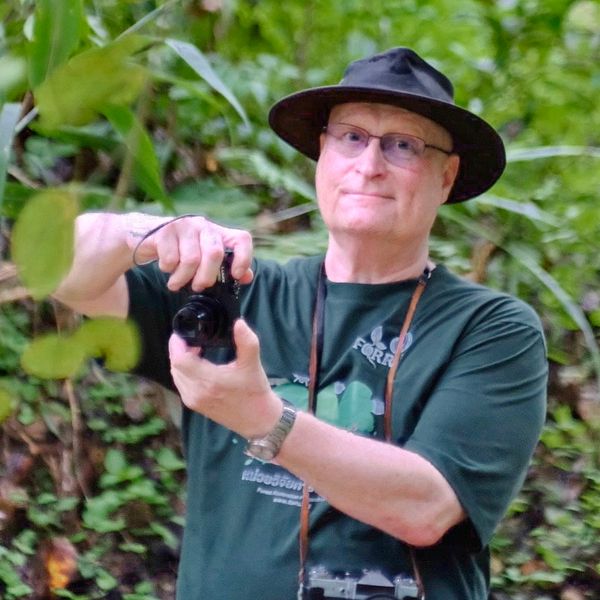ผม (ดร.สตีเฟ่น เอลเลียต)ได้พบกับคุณนูนีครั้งแรกไม่นานหลังจากที่เดินทางมาถึงเชียงใหม่ เพื่อมาสอนวิชานิเวศวิทยาในภาควิชาชีววิทยา มหาวิทยาลัยเชียงใหม่ ในปี พ.ศ. 2529 โอกาสนั้นคืองานสัมมนาที่คณะมนุษยศาสตร์เกี่ยวกับการจัดการทรัพยากรธรรมชาติ หญิงไทยตัวเล็ก ๆ คนหนึ่งกำลังพูดภาษาอังกฤษสำเนียงควีนส์อิงลิชอย่างชัดเจน เกี่ยวกับโครงการที่อำเภอจอมทอง เพื่อฟื้นฟูป่าไม้ในพื้นที่ต้นน้ำของหุบเขาแม่สอย เขาคือคนที่เชื่อว่าการทำลายป่าส่งผลกระทบอย่างร้ายแรงต่อพื้นที่ต้นน้ำและสัตว์ป่า ดังนั้นวิธีการฟื้นฟูป่าสามารถช่วยให้ฟื้นฟูระบบนิเวศกลับมาได้จริง คุณนูนีได้ร่วมก่อตั้งมูลนิธิธรรมนาถ (Dhammanaat Foundation) ร่วมกับพระอาจารย์พงษ์ศักดิ์ โดยเริ่มต้นบุกเบิกโครงการฟื้นฟูระบบนิเวศป่าธรรมชาติด้วยการปลูกต้นไม้ป่าท้องถิ่นหลากหลายชนิด ใน ณ ตอนนั้นหน่วยงานอื่น ๆ คิดแค่การปลูกต้นสนและยูคาลิปตัสเพียงเท่านั้น คุณนูนีสามารถโน้มน้าวใจให้โครงการนิเวศวิทยาให้มีความเป็นรูปธรรมจริงจังซึ่งโครงการแรกที่ผมได้พบ นับตั้งแต่มาถึงประเทศไทย ทำให้ผมรู้สึกประทับใจและอยากมีส่วนร่วมกับโครงการฟื้นฟูที่คุณนูนีทันที
คุณนูนีมักดูจะไม่ค่อยมั่นใจในตัวเองบ่อยครั้ง อาจเป็นเพราะเขาไม่ได้รับการศึกษาทางด้านวิทยาศาสตร์อย่างเป็นทางการ แต่เธอก็ชดเชยจุดนี้ได้อย่างหมดจดด้วยความกระตือรือร้นที่ไม่เคยหมดสิ้นในการอนุรักษ์ธรรมชาติ และความขยันที่ทำให้นักศึกษาที่อายุน้อยกว่าเธอครึ่งหนึ่งต้องอับอาย คุณนูณีได้ทำงานร่วมกับนักพฤกษศาสตร์วิทยา เจ. เอฟ. แมกซ์เวลล์ (อาจารย์แมกซ์) เพื่อเรียนรู้การจำแนกชนิดพันธุ์พืชในพื้นที่ลุ่มน้ำแม่สอยเป็นส่วนใหญ่ และบริเวณรอบบ้านของเธอที่ดอยสุเทพ ความรู้เหล่านี้ได้ถูกนำมาใช้อย่างคุ้มค่า มีการเก็บเมล็ดพันธุ์ และเพาะกล้าไม้หลากหลายชนิดในสถานเพาะชำของมูลนิธิธรรมนาถ เพื่อปลูกฟื้นฟูในพื้นที่ลุ่มน้ำ

กล่าวได้เลยว่า คุณนูนีเป็นแรงบันดาลใจสำคัญที่หล่อหลอมทิศทางชีวิตของทั้งคุณเคทและผมอย่างมาก หลังจากที่ คุณเคทฝึกงานกับมูลนิธิธรรมานาถ เธอก็ไปเรียนต่อจนจบปริญญาเอกด้านการฟื้นฟูป่า ส่วนผมก็หันมาทุ่มเทให้กับปัญหาทางเทคนิคกานฟื้นฟูป่าโดยเฉพาะ ปัญหาที่คุณนูนีเจอในการพยายามฟื้นฟูป่าในหุบเขาแม่สรวยส่วนใหญ่เกิดจากการขาดข้อมูลทางนิเวศวิทยาเกี่ยวกับพันธุ์ไม้ของไทย เช่น ควรก็บเมล็ดพันธุ์เมื่อไหร จะเพาะต้นกล้าในเรือนเพาะชำได้อย่างไร หรือควรปลูกพืชชนิดไหนในพื้นที่ใด
คุณนูนีเลยสนับสนุนให้ผมตั้งเรือนเพาะชำวิจัยเพื่อศึกษาคำถามเหล่านี้ เธอแนะนำผมให้รู้จักกับนักพฤกษศาสตร์วิทยา ดร.เดวิด เบลคส์ลีย์ จากมหาวิทยาลัยบาธ สหราชอาณาจักร ซึ่งต่อมาเราได้ร่วมกันสร้างความร่วมมือทางวิชาการที่ประสบความสำเร็จและดำเนินมาจนถึงทุกวันนี้ ผม คุณเคท และอาจารย์วิไลวรรณ อนุสารสุนทร (เพื่อนร่วมงานที่มหาวิทยาลัยเชียงใหม่) เริ่มวางแผน ต่อมาจึงเป็น หน่วยวิจัยการฟื้นฟูป่า มหาวิทยาลัยเชียงใหม่ (FORRU-CMU)
คุณนูนีมีส่วนสำคัญอย่างยิ่งในการช่วยให้เราเริ่มต้น FORRU-CMU ได้ หลังจากพยายามโน้มน้าวหน่วยงานช่วยเหลือต่างๆ ให้สนับสนุนโครงการนี้มานานกว่าหนึ่งปีแต่ไม่สำเร็จ ผมก็ได้รับเชิญไปดื่มชาและทานบิสกิตที่สวนหน้าบ้านของคุณนูนี ภายในบริเวณวัดป่าแดด เธอได้แนะนำผมให้รู้จักกับ มาร์ค แกรห์ม ผู้ซึ่งเป็นตัวแทนของบริษัท Richmond (Bangkok) Ltd. กำลังมองหาโครงการด้านสิ่งแวดล้อม เพื่อสนับสนุนจากกองทุนเพื่อสังคมของบริษัท เพียงไม่กี่สัปดาห์ต่อมา ผมก็ได้รับเงินที่จำเป็นสำหรับการเริ่มสร้างเรือนเพาะชำวิจัยของ FORRU-CMU ยิ่งไปกว่านั้น คุณนูนีเป็นคนออกแบบโลโก้ของหน่วยวิจัยการฟื้นฟูป่าให้ด้วยตัวเธอเอง

ความสนใจในธรรมชาติของคุณนูนีไม่ได้จำกัดอยู่แค่ต้นไม้เท่านั้น เธอชื่นชอบพืช สัตว์ และสิ่งมีชีวิตบางกลุ่มที่คนทั่วไปอาจไม่ค่อยนิยม เช่น เห็ดรา และ แมลงน้ำ เธอให้การสนับสนุนการจัดการอบรมเรื่อง ผีเสื้อกลางคืน และ ไลเคน ที่ภาควิชาชีววิทยาของมหาวิทยาลัยเชียงใหม่ และเข้าร่วมกิจกรรมทั้งสองอย่างกระตือรือร้น นอกจากนี้ พรสวรรค์ทางศิลปะของเธอยังถูกนำมาใช้เพื่อส่งเสริมให้เยาวชนเห็นคุณค่าของธรรมชาติ ด้วยการสร้างสรรค์โปสเตอร์และสื่อการสอนให้กับมูลนิธิโลกสีเขียว

ในต้นปีพ.ศ. 2542 ผมได้รับเกียรติเชิญคุณนูนี่มาพูดในงานอบรมในระดับภูมิภาคหัวข้อ “การฟื้นฟูป่าเพื่อการอนุรักษ์สัตว์ป่า” ซึ่งจัดโดย FORRU-CMU แม้เธอจะกังวลกับการเป็นวิทยากรหลักในงานเชิงวิชาการ เช่นนี้ แต่เธอก็ไม่จำเป็นต้องเป็นห่วงเลย การนำเสนออันเปี่ยมด้วยความรู้ของเธอในหัวข้อ “'River in Jeopardy” เกี่ยวกับการฟื้นฟูป่าในหุบเขาแม่สรอยตอนบน เป็นหนึ่งในไฮไลท์ของงานอบรม และเข้ากันได้ดีกับบทความของผู้เชี่ยวชาญด้านป่าไม้ชั้นนำ
ผมได้พบเธอกับเธออีกเพียงสองสามครั้งหลังจากการประชุม แม้สุขภาพของเธอจะทรุดโทรมลง แต่ความกระตือรือร้นในชีวิตของเธอก็ยังคงเหมือนเดิม ผมไม่คิดเลยว่านั่นจะเป็นครั้งสุดท้ายที่เราจะได้ร่วมดื่มชา ผมจะคิดถึงมิตรภาพของเธอ กำลังใจที่เธอมีให้เสมอ บทสนทนาที่มักจุดประกายความคิด และความกระหายใคร่รู้ของเธอเวลาที่เราเดินป่าด้วยกัน ที่สำคัญกว่านั้น โลกธรรมชาติได้สูญเสียผู้พิทักษ์ที่ทุ่มเทที่สุดคนหนึ่งไป และการจากไปของเธอยิ่งทำให้ธรรมชาติเปราะบางลง


